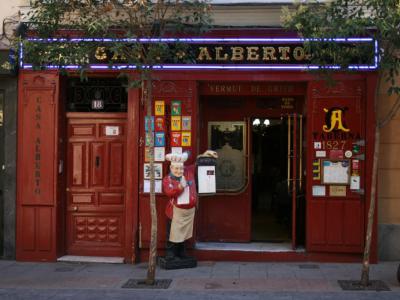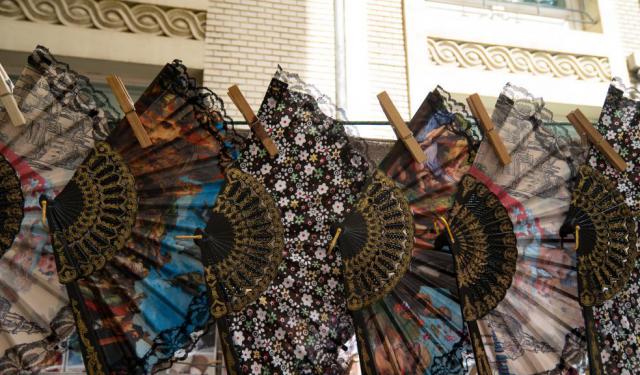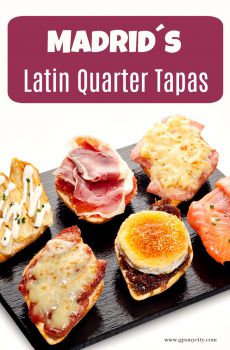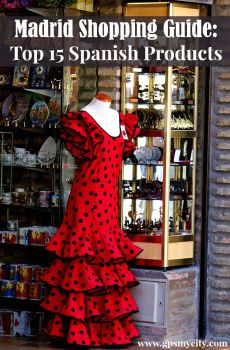
Miguel de Cervantes' Madrid Walking Tour (Self Guided), Madrid
The name of the iconic Spanish writer Miguel de Cervantes is closely associated with Madrid. The author is known for a number of works, but his 1605 novel Don Quixote de la Mancha is often held as the first modern novel.
Despite being regarded as one of the fathers of modern literature, very little is known about Cervantes' early life. Born in 1547, he had spent some of his young years in the Madrid suburb of Alcalá de Henares. Later, whilst in the capital, he combined writing with managing various governmental jobs. The current No. 2 Cervantes Street address is where the writer lived for a long time. It is commonly believed that he had written Don Quixote and Los Trabajos de Persiles y Sigismunda at the site of present-day Alberto's Tavern.
Cervantes passed away in 1616 and was buried at the Convent of the Barefoot Trinitarians, now marked with a memorial plaque. Several other statues and monuments to Cervantes are found throughout the city, not to mention the entire Literary District. This area was home not only to Cervantes, but also to other luminaries like Lope de Vega.
If you care to follow in the footsteps of Don Quixote himself, chase some windmills and see Madrid through the eyes of the great writer, follow us on this Cervantes Walking Tour.
Despite being regarded as one of the fathers of modern literature, very little is known about Cervantes' early life. Born in 1547, he had spent some of his young years in the Madrid suburb of Alcalá de Henares. Later, whilst in the capital, he combined writing with managing various governmental jobs. The current No. 2 Cervantes Street address is where the writer lived for a long time. It is commonly believed that he had written Don Quixote and Los Trabajos de Persiles y Sigismunda at the site of present-day Alberto's Tavern.
Cervantes passed away in 1616 and was buried at the Convent of the Barefoot Trinitarians, now marked with a memorial plaque. Several other statues and monuments to Cervantes are found throughout the city, not to mention the entire Literary District. This area was home not only to Cervantes, but also to other luminaries like Lope de Vega.
If you care to follow in the footsteps of Don Quixote himself, chase some windmills and see Madrid through the eyes of the great writer, follow us on this Cervantes Walking Tour.
How it works: Download the app "GPSmyCity: Walks in 1K+ Cities" from Apple App Store or Google Play Store to your mobile phone or tablet. The app turns your mobile device into a personal tour guide and its built-in GPS navigation functions guide you from one tour stop to next. The app works offline, so no data plan is needed when traveling abroad.
Miguel de Cervantes' Madrid Walking Tour Map
Guide Name: Miguel de Cervantes' Madrid Walking Tour
Guide Location: Spain » Madrid (See other walking tours in Madrid)
Guide Type: Self-guided Walking Tour (Sightseeing)
# of Attractions: 5
Tour Duration: 1 Hour(s)
Travel Distance: 1.2 Km or 0.7 Miles
Author: emily
Sight(s) Featured in This Guide:
Guide Location: Spain » Madrid (See other walking tours in Madrid)
Guide Type: Self-guided Walking Tour (Sightseeing)
# of Attractions: 5
Tour Duration: 1 Hour(s)
Travel Distance: 1.2 Km or 0.7 Miles
Author: emily
Sight(s) Featured in This Guide:
- Plaza de las Cortes (Cortes Square)
- Casa Miguel de Cervantes (Cervantes House)
- Convento de las Trinitarias Descalzas (Convent of the Barefoot Trinitarians)
- Casa Alberto (Alberto's Tavern)
- Sociedad Cervantina (Cervantes Society)
1) Plaza de las Cortes (Cortes Square)
Plaza de las Cortes is a prominent square surrounded by neoclassical buildings that showcase some of Madrid's finest architecture. Every corner reveals a structure with intricate details to appreciate. On the northern side stands the Parliament Palace ("Palacio de las Cortes"), a 19th-century building where the lower house of the Spanish parliament convenes. Its entrance is guarded by two bronze lions, crafted from a cannon melted down during the African War of 1859–60. Another notable landmark is the Westin Palace, which opened in 1912 as the largest and most modern hotel in Europe, with over 400 rooms, telephones, and en suite toilets.
At the center of the triangular-shaped square stands a grand statue honoring the renowned Spanish writer, Miguel de Cervantes. Erected in 1835, it was the first secular statue in Madrid that wasn't dedicated to royalty at the time. In 2009, a time capsule was discovered within its pedestal, containing a well-preserved 1819 printing of "Don Quixote" and other publications and artifacts. These items are now held at the Regional Archaeological Museum ("Museo Arqueológico Regional") in Alcalá de Henares, near Cervantes' birthplace in 1547.
Although many details of Cervantes' early life are debated, it is known that he and his family resided in Cordoba for several years before returning to Madrid. He worked for a cardinal in Rome before joining the Spanish military, where he was severely wounded in the Battle of Lepanto in 1571. Despite his injuries, he survived and received recognition for his bravery. In 1575, Cervantes and his brother Rodrigo were captured by the Ottomans while aboard the galley Sol. They were held captive in Algiers, with only Rodrigo being released after their family paid a ransom. Cervantes remained in captivity until his freedom was finally secured in 1580.
Following his release, Cervantes held various government positions, including an intelligence agent in Africa and a tax collector in Seville. It was during this period that he completed some of his most famous works, including "La Galatea" in 1585. He later returned to Madrid, where he spent the rest of his life. In 1605, he published the first volume of "Don Quixote", followed by the second volume ten years later, cementing his status as one of the most renowned figures in Spanish literature.
At the center of the triangular-shaped square stands a grand statue honoring the renowned Spanish writer, Miguel de Cervantes. Erected in 1835, it was the first secular statue in Madrid that wasn't dedicated to royalty at the time. In 2009, a time capsule was discovered within its pedestal, containing a well-preserved 1819 printing of "Don Quixote" and other publications and artifacts. These items are now held at the Regional Archaeological Museum ("Museo Arqueológico Regional") in Alcalá de Henares, near Cervantes' birthplace in 1547.
Although many details of Cervantes' early life are debated, it is known that he and his family resided in Cordoba for several years before returning to Madrid. He worked for a cardinal in Rome before joining the Spanish military, where he was severely wounded in the Battle of Lepanto in 1571. Despite his injuries, he survived and received recognition for his bravery. In 1575, Cervantes and his brother Rodrigo were captured by the Ottomans while aboard the galley Sol. They were held captive in Algiers, with only Rodrigo being released after their family paid a ransom. Cervantes remained in captivity until his freedom was finally secured in 1580.
Following his release, Cervantes held various government positions, including an intelligence agent in Africa and a tax collector in Seville. It was during this period that he completed some of his most famous works, including "La Galatea" in 1585. He later returned to Madrid, where he spent the rest of his life. In 1605, he published the first volume of "Don Quixote", followed by the second volume ten years later, cementing his status as one of the most renowned figures in Spanish literature.
2) Casa Miguel de Cervantes (Cervantes House)
Miguel de Cervantes resided at what is now known as No. 2 Cervantes Street, although the street had a different name during his time—Francos Street. Interestingly, another esteemed Spanish writer, Lope de Vega, had also lived there. Although the house is marked with plaques and a relief of Cervantes, it is not open for public tours.
In 1833, the owner of the writer's house planned to demolish it and rebuild. An article about the edifice was published in a literary newspaper, catching the attention of King Fernando VII. The king sought to acquire the property for the state and restore the structure, but the owner declined and proceeded with the demolition. The new building that stands there today pays tribute to the author, and the street was renamed to commemorate Cervantes' residency.
The house is situated in Madrid's Literary Quarter, named in honor of the talented artists who have graced its charming streets throughout history. Huertas Street, the main thoroughfare of the Literary Quarter, features quotes from renowned Spanish writers inscribed on the sidewalks. On Cervantes Street, you will also find a house and museum dedicated to Lope de Vega.
Cervantes passed away in this house in 1616 and was laid to rest at the nearby Convent of the Trinitarians.
In 1833, the owner of the writer's house planned to demolish it and rebuild. An article about the edifice was published in a literary newspaper, catching the attention of King Fernando VII. The king sought to acquire the property for the state and restore the structure, but the owner declined and proceeded with the demolition. The new building that stands there today pays tribute to the author, and the street was renamed to commemorate Cervantes' residency.
The house is situated in Madrid's Literary Quarter, named in honor of the talented artists who have graced its charming streets throughout history. Huertas Street, the main thoroughfare of the Literary Quarter, features quotes from renowned Spanish writers inscribed on the sidewalks. On Cervantes Street, you will also find a house and museum dedicated to Lope de Vega.
Cervantes passed away in this house in 1616 and was laid to rest at the nearby Convent of the Trinitarians.
3) Convento de las Trinitarias Descalzas (Convent of the Barefoot Trinitarians)
Miguel de Cervantes had a heartfelt desire to be laid to rest within the confines of Madrid's expansive Convent of the Barefoot Trinitarians, where a small group of cloistered nuns continue to reside to this day, almost four centuries later. What many are unaware of is that Cervantes owes the existence of his literary works to the Trinitarian nuns of his time, as he believed they saved his life. This belief stemmed from his own courageous escapades before he penned his two-volume masterpiece, "Don Quixote de La Mancha".
In his early twenties, Cervantes left Spain and sought refuge in Rome after engaging in a duel that resulted in him injuring a nobleman. By 1570, he had returned to his homeland and joined the Spanish navy, embarking on a war to defend the Pope. During this conflict, he sustained gunshot wounds to his ribs and shoulder, the latter of which left his left arm paralyzed. To compound matters, he was subsequently captured by Algerian pirates and endured five harrowing years as their slave.
While Cervantes languished in captivity in Africa, his family reached out to the Trinitarian nuns for assistance. Through their efforts, a ransom was raised and delivered to the pirates, securing Cervantes' freedom. The aspiring author returned to Spain, profoundly grateful, and offered his prayers at the 17th-century convent of the Trinitarians.
In his early twenties, Cervantes left Spain and sought refuge in Rome after engaging in a duel that resulted in him injuring a nobleman. By 1570, he had returned to his homeland and joined the Spanish navy, embarking on a war to defend the Pope. During this conflict, he sustained gunshot wounds to his ribs and shoulder, the latter of which left his left arm paralyzed. To compound matters, he was subsequently captured by Algerian pirates and endured five harrowing years as their slave.
While Cervantes languished in captivity in Africa, his family reached out to the Trinitarian nuns for assistance. Through their efforts, a ransom was raised and delivered to the pirates, securing Cervantes' freedom. The aspiring author returned to Spain, profoundly grateful, and offered his prayers at the 17th-century convent of the Trinitarians.
4) Casa Alberto (Alberto's Tavern)
Established in 1827, Casa Alberto has maintained its presence in the same location for nearly two centuries. Specializing in authentic Madrilenian cuisine, this restaurant has attracted notable figures in the city since its inception. Renowned for its caracoles (snails), gambas (prawns), and exquisite croquetas, it offers a delightful culinary experience that pairs perfectly with a glass of house vermouth.
The building itself stands on the foundations of a 16th-century structure that once served as the residence of the esteemed writer Miguel de Cervantes. To commemorate this historical connection, a plaque adorns the restaurant's wall, as it is believed that Cervantes penned his works "Don Quixote" and "Los Trabajos de Persiles y Sigismunda" within these walls.
During the mid-1800s, cafes and theaters gained popularity throughout the city, and Casa Alberto became a favored dining destination for those visiting the nearby Prado National Museum, which opened its doors in 1819. In 1924, the restaurant underwent a renovation, acquiring its present elegant decor and swiftly establishing itself as a must-visit establishment for both locals and tourists. Over the years, theater actors, politicians, and the city's elite have all savored meals here.
The decor exudes a sense of timelessness, adorned with functional antiques. Notably, the tin bar showcases a distinctive sink that once cooled wine bottles and served as a washing area for glasses. Upstairs, visitors can explore a collection of Cervantes memorabilia, adding to the rich historical ambiance.
The building itself stands on the foundations of a 16th-century structure that once served as the residence of the esteemed writer Miguel de Cervantes. To commemorate this historical connection, a plaque adorns the restaurant's wall, as it is believed that Cervantes penned his works "Don Quixote" and "Los Trabajos de Persiles y Sigismunda" within these walls.
During the mid-1800s, cafes and theaters gained popularity throughout the city, and Casa Alberto became a favored dining destination for those visiting the nearby Prado National Museum, which opened its doors in 1819. In 1924, the restaurant underwent a renovation, acquiring its present elegant decor and swiftly establishing itself as a must-visit establishment for both locals and tourists. Over the years, theater actors, politicians, and the city's elite have all savored meals here.
The decor exudes a sense of timelessness, adorned with functional antiques. Notably, the tin bar showcases a distinctive sink that once cooled wine bottles and served as a washing area for glasses. Upstairs, visitors can explore a collection of Cervantes memorabilia, adding to the rich historical ambiance.
5) Sociedad Cervantina (Cervantes Society)
The Cervantine Society, dedicated to promoting the works of Cervantes, can be found at 87 Atocha Street. A plaque commemorates the location where Juan de la Cuesta's printing press once stood, publishing the first edition of "Don Quixote" in 1605.
Established in 1953 by esteemed Cervantes scholar Luis Astrana Marín, the society is committed to exploring and disseminating the life and literary contributions of the 17th-century author. They organize immersive routes through the landscapes featured in "Don Quixote" and offer educational courses on various aspects related to Cervantes. Within this location, you will also discover the Cervantes Theatre, a venue offering an array of captivating performances.
In 2008, the Society embarked on a project to recreate the original printing press from the Golden Age. The printing press area has been carefully designed to fully immerse visitors in the artistry and craftsmanship of the skilled artisans who once labored here. It offers a unique opportunity to delve into the intricate printing techniques of that era and to explore the distinctive features of the first edition of "Don Quixote" through an engaging guided tour that caters to visitors of all ages.
Beyond immortalizing Cervantes' literary masterpiece, this particular printing press also played a pivotal role in producing more than a dozen works by renowned Spanish authors such as Lope de Vega, Tirso de Molina, and Calderón de la Barca.
Established in 1953 by esteemed Cervantes scholar Luis Astrana Marín, the society is committed to exploring and disseminating the life and literary contributions of the 17th-century author. They organize immersive routes through the landscapes featured in "Don Quixote" and offer educational courses on various aspects related to Cervantes. Within this location, you will also discover the Cervantes Theatre, a venue offering an array of captivating performances.
In 2008, the Society embarked on a project to recreate the original printing press from the Golden Age. The printing press area has been carefully designed to fully immerse visitors in the artistry and craftsmanship of the skilled artisans who once labored here. It offers a unique opportunity to delve into the intricate printing techniques of that era and to explore the distinctive features of the first edition of "Don Quixote" through an engaging guided tour that caters to visitors of all ages.
Beyond immortalizing Cervantes' literary masterpiece, this particular printing press also played a pivotal role in producing more than a dozen works by renowned Spanish authors such as Lope de Vega, Tirso de Molina, and Calderón de la Barca.
Walking Tours in Madrid, Spain
Create Your Own Walk in Madrid
Creating your own self-guided walk in Madrid is easy and fun. Choose the city attractions that you want to see and a walk route map will be created just for you. You can even set your hotel as the start point of the walk.
Madrid Food Tour
Spain is internationally reputed as a major gastronomic power and its capital city Madrid attests to this claim, being home to vibrant food markets and multiple establishments serving traditional Spanish food in a soul-warming atmosphere.
One of the iconic food destinations is Plaza Mayor, a bustling town square where you can savor traditional Spanish dishes. The square is home to numerous... view more
Tour Duration: 1 Hour(s)
Travel Distance: 1.8 Km or 1.1 Miles
One of the iconic food destinations is Plaza Mayor, a bustling town square where you can savor traditional Spanish dishes. The square is home to numerous... view more
Tour Duration: 1 Hour(s)
Travel Distance: 1.8 Km or 1.1 Miles
Souvenirs Shopping Tour
Shopping for souvenirs in Madrid is an exciting and delightful experience for anyone visiting the vibrant Spanish capital. Indeed, it would be a pity to leave Madrid without having explored its specialty shops and bringing home something truly original. With this in mind, we've compiled a list of must-visit locations where you can find souvenirs, which are unique to Madrid and make for... view more
Tour Duration: 1 Hour(s)
Travel Distance: 1.0 Km or 0.6 Miles
Tour Duration: 1 Hour(s)
Travel Distance: 1.0 Km or 0.6 Miles
Madrid Introduction Walking Tour
A city of elegant boulevards, beautiful squares, and manicured parks, the Spanish capital is renowned for its rich repositories of European art, portico-lined Plaza Mayor, baroque style Royal Palace and many other cultural and historical monuments.
Although the site of modern-day Madrid has been occupied since prehistoric times, the first historical document about an established settlement here... view more
Tour Duration: 2 Hour(s)
Travel Distance: 3.8 Km or 2.4 Miles
Although the site of modern-day Madrid has been occupied since prehistoric times, the first historical document about an established settlement here... view more
Tour Duration: 2 Hour(s)
Travel Distance: 3.8 Km or 2.4 Miles
Ernest Hemingway's Madrid Walking Tour
Amid the many writers who have expressed their love for Madrid, Ernest Hemingway is the one who did so quite famously. A recognized heavyweight of the 20th century literature - the author of The Sun Also Rises (1926), Death in the Afternoon (1932), The Fifth Column (1938), For Whom the Bell Tolls (1940) and The Old Man and the Sea (1952) - was a frequent visitor to the Spanish capital.
Here,... view more
Tour Duration: 1 Hour(s)
Travel Distance: 2.5 Km or 1.6 Miles
Here,... view more
Tour Duration: 1 Hour(s)
Travel Distance: 2.5 Km or 1.6 Miles
Golden Mile Walking Tour
Similarly to 5th Avenue in New York City, Champs Elysee in Paris, or Bond Street in London, the Golden Mile is one of the wealthiest and most expensive neighborhoods of the Spanish capital. Forming part of Madrid's Salamanca district, this posh area is known for its upscale shopping, cultural attractions, and gastronomic delights.
One of the prominent local landmarks is Columbus Square... view more
Tour Duration: 1 Hour(s)
Travel Distance: 2.5 Km or 1.6 Miles
One of the prominent local landmarks is Columbus Square... view more
Tour Duration: 1 Hour(s)
Travel Distance: 2.5 Km or 1.6 Miles
Buen Retiro Park Walking Tour
Buen Retiro Park, which translates to "Park of the Pleasant Retreat", is one of the main attractions in Madrid. Similarly to Central Park of New York City or Hyde Park of London, this former royal retreat is the most popular public outdoor space in the Spanish capital.
A green oasis in the heart of the city, the park has long been a favorite spot for both locals and tourists to go for... view more
Tour Duration: 2 Hour(s)
Travel Distance: 3.9 Km or 2.4 Miles
A green oasis in the heart of the city, the park has long been a favorite spot for both locals and tourists to go for... view more
Tour Duration: 2 Hour(s)
Travel Distance: 3.9 Km or 2.4 Miles
Useful Travel Guides for Planning Your Trip
10 Uniquely Madrid Foods to Try in Spanish Capital
There’s no better way to fall in love with a city than through its traditional cuisine. Complete meals, appetizers, beverages and sweets: all of them draw a path to a tourist heart. Madrid, the Spanish capital, has its very own unique and original dishes that can make a stay in this city a...
Madrid´s Latin Quarter Tapas
This app is a description of bars and cafeterias of tapas and pinchos in the Latin Quarter of Madrid. Tapas and pinchos are generally bar snacks and finger foods, with pinchos generally originating from the Basque Country. The custom of tapas and pinchos-eating refers to eating at the bar, sometime...
Top 16 Bars in Madrid
Madrid, the third largest city in Western Europe, is packed with an eclectic mix of bars that offer a scene for every style. In Spain’s Capital city, alcohol flows without end. Just take a walk down the streets of this vibrant city, and it seems as if every other building is a café or bar...
A Self-Guided Food Walk in Madrid
The reputation of Spain as a major gastronomic power to reckon with goes a long way. The capital city of Madrid has a lot to offer visitors in terms of soul warming food experience. On this walk you will visit some of the city's most vibrant and lively food markets and other places serving...
Madrid Souvenir Shopping Guide: Top 15 Spanish Products
They call Spain "magnificent" for a reason, as there're loads of fascinating stuff a visitor to the country might want to take home and share with family and friends. Luckily, in Madrid one can find nearly all that Spain is famous for - wine, food, fashion, arts, sports, etc. Good...
The Most Popular Cities
/ view all
















